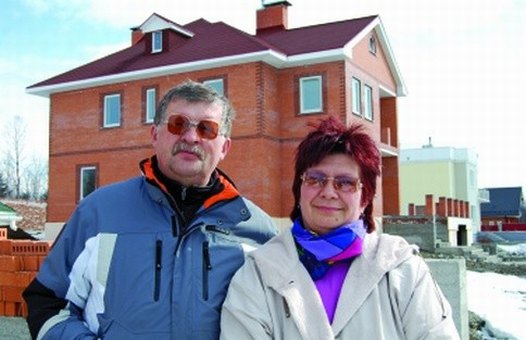On the outskirts of the town of Apaptity, in the Kola-peninsula, we find one of the first congregations of new villas, or "cottages" as the Russians call them, in Northwest-Russia. Since much of the work is done according to the individual house-owner's capital supply most of the houses are built step by step. When they are all finished, there will be some 35 dwellings here in "Severyanin", meaning "the Northern Peoples Settlement". This is what the house owners call the area. However, people in general tend to call these types of developments "Rublovka", meaning cottage village castles.

Larisa and Valery Vyatkina in front of their new house in Severyanin. Photo Odd Iglebaek
Severyanin began in 2003 when a group of friends went to the municipality with a plan to build individual family-houses on this area of land. Eventually the authorities said "yes" but they maintained that those involved had to pay for everything them-selves; the infrastructure, removing the forest layer on the plot, roads, water-supply, electricity etc. The message was that if this was not done, the project would not be allowed to move forward explains Larisa Vyatkina, the project's driving force.
Currently around half of the 35 plots are being developed. Some houses are finished and people have already moved in. The infrastructure is in place, but the roads remain unimproved with no all-weather surface. The architectural styles used vary significantly, some house are timber-structures while others are made using concrete and bricks. Floor-space per house spans a range from 150 up to 400 m2. Generally speaking, the owners and their families participate in the construction process. In one house we visited the owners had spent five years making concrete blocks. It is a large house, so there has not been much time yet for 'dacha-life' in this family.
– Usually the building cost is 23 000 roubles (700 euros) per square-metre. The cost of the infrastructure is likely to be around 500 000 roubles for each plot, usually around 1000 m2. However, so far we do not how much we will pay for the actual land to the municipality. That is still being negotiated, says Larisa Vyatkina.
- Other groups of people in Apatity have also tried to launch similar schemes but have generally been unsuccessful lacking perhaps the drive of our chair-woman, explains Elena Vasilevja, a friend of Larisa Vyatkina.
Most people who build in Severyanin are involved in business. Some also work at the Kombinat, the large mine and factory for extracting and graining the apatite, used as fertilizer, upon which all development in the region was originally based. The first town to be built here was Kirovsk which was in established in 1929. The town is surrounded by mountains and soon further expansion was required. Therefore the neighbouring settlement "New Town" was merged with other units and given town status as Apatity in 1966.
Today Apatity has some 31 000 flats, around 15 000 dachas (for growing vegetables) and 10 000 garages. Most of the later are relatively old structures and rarely see cars. They tend instead to function as storage areas and as 'free-space' for the male segment of the population.
In population terms Apatity reached its peak in 1989 with 88 000 inhabitants. Today this number is below 61 000. One major reason for this rapid decline is the closure of the large construction company that used to provide a significant number of jobs. In addition, the Kombinat or Apatit as it is now officially called has experienced a similar development. The number of employees has fallen in the same period from 20 000 to below 12 000. The company nevertheless remains the largest mining and concentrates enterprise in Europe (including Russia). Other large employers in Apatity are the Kola Science Centre of the Russian Academy of Science and Apatity Heating Power Station.
Larisa Vyatkina and her husband Valery are among those who are building very large houses in Severyanin. They hope to have three generations of their family living under the same roof. But this is not very realistic as the young leave to move south if they cannot find interesting jobs, which in reality few are able to do, she explains.
She also thinks that it will be difficult to sell these large houses, at least to make a profit. So why do they do it? – You know, to build is a lifestyle, concludes the eager spokeswoman.
By Odd Iglebaek